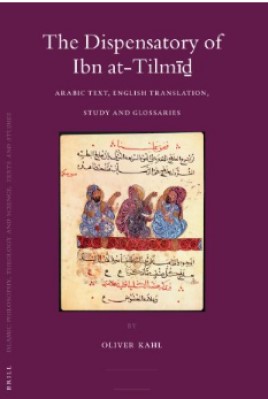The Dispensatory of Ibn at-Tilmid – Arabic Text, English Translation, Study and Glossaries

| The Dispensatory Of Ibn At Tilmid |
| Oliver Kahl |
| 360 |
| |
| PDF Direct Download Link |
| Click for Hard Copy from Amazon |
THE DISPENSATORY OF IBN AT-TILMID – Book Sample
“Pharmacy then is the knowledge of chosen simple drugs in regard to their species, varieties and forms, as well as the mixture of compound drugs on the basis of written prescriptions or in accordance with what a trustworthy and skilful man may have contrived” The muslim polymath abu r-Raihan al-Biruni in the preface to his aidana ff t-tibb (completed mid 11th century CE)
Towards a History of Arabic Pharmacology
If we were to compare Arabic pharmacology to a building, we would be looking at a very elaborate and complex architectural structure, made by using materials and styles from different parts of the world and joining them together in an ingenious though somewhat idiosyncratic fashion. Studying such a structure is necessarily both challenging and rewarding—the challenge arising from its compositional diversity, the reward resulting from its conceptual harmony.
The conditions for the rise of Arabic pharmacology are varied. First and foremost there is the Arabic reception of foreign scientific traditions in the course of a translation movement which took place between the middle of the 2nd/8th and the end of the 4th/10th centuries in Baghdad,4 and which acquainted the Arabs with the medico-philosophical theories as well as the medico-pharmacological practices notably of the Greeks and Indians, either through direct translations from Greek and Sanskrit or through Syriac and Pahlavi intermediates; the translation movement also played a major rôle in the formation of a professional language, that is in developing Arabic into a language of scientific and philosophical discourse.
Then there are the commercial and to some extent cultural relations with at least the southern regions of China, which brought the Arabs in contact with certain aspects of Chinese herbal medicine. And lastly there is the enormous geographical extension of the Abbasid empire, stretching from the Atlantic to the Indian Ocean and from the Caucasus down to the Horn of Africa, which facilitated trade and made possible the acquisition and relatively safe transport of medicinal drugs from all corners of the then known world.
The earliest pharmacological works in Arabic of which we possess more or less complete textual witnesses appeared, seemingly out of nowhere, around the middle of the 3rd/9th century, and in their high degree of literary organization and deliberate use of technical jargon they already bear the markings of a scientific genre. Due to a lack of authentic Arabic source material for the formative period we can only employ common sense and draw the general conclusion that the old Arab scholars sliced and spliced preceding pharmacological traditions with remarkable swiftness, great skill, and a fair measure of intuition.
The particular scientific form which Arabic pharmacology had assumed in the course of the 3rd/9th century was to become the basic pattern for almost all later literary activities in the field, and it is in precisely this form that we find Arabic pharmacology also lying at the crossroads of other, related scientific genres—medicine with its semiphilosophical base of humoral pathology; botany both theoretical and applied;5 mineralogy; zoology; alchemy insofar as its chemical principles may be concerned; and occasionally even astrology as a means to iatromathematical ends.
It follows from all this that an adequate understanding of the structural features of Arabic pharmacology requires an extremely broad approach, whilst its expressional features can only be studied through a magnifying glass. For certain periods in the history of Arabic pharmacology, that is with regard to specific pharmacological texts in historical settings which are reasonably well known, this task can today be tackled with a good chance of success, though still a relatively large amount of effort. Yet a general history of Arabic pharmacology above and beyond a merely chronological or descriptive plane—an ‘inner’ history of the subject that proceeds to interpret its heterogeneous origins, diverging and converging lines of development, classic manifestations, and eventual stagnation at the very point of congruency with other scientific structures in late mediaeval Arab society—such a thing must remain in the realm of the future.6 There are several reasons which call for restraint. Arabic pharmacological texts inevitably cover vast, and partly still uncharted territories.
We already mentioned the different scientific disciplines which intersect with mediaeval Arabic pharmacology, and which must be understood well enough to inform its study on the level of natural principles; but there is also a delicate range of source languages which need to be considered in order to arrive at justifiable historical interpretations of the subject, and which include, apart from the obvious Arabic, at least Greek, Syriac and Persian, and ideally also Sanskrit and Chinese.
Rare exceptions granted, the individual scholar of modern day more often than not finds himself stretched beyond the limits of his expertise when trying to adequately deal with the diverse material under his hands, and wishes for institutional conditions and intellectual attitudes more favourable to interdisciplinary collaboration—as matters stand, the historian of Arabic pharmacology better get used to single-tracking.
Another problem is the lack of calibrated theoretical tools with which to work the material, and the absence of generally acknowledged methodological approaches even among historians, let alone representatives of ‘exact’ science—this means that already the most basic questions, like how the achievements of earlier scientific traditions ought to be measured, remain subject to dissent.
Then there is in our contemporary world an ever widening gap between the natural and the social sciences which renders next to impossible any attempts at re-establishing a mutually comprehensible terminology,…..
To read more about the The Dispensatory Of Ibn At Tilmid book Click the download button below to get it for free
Report broken link
Support this Website
for websites